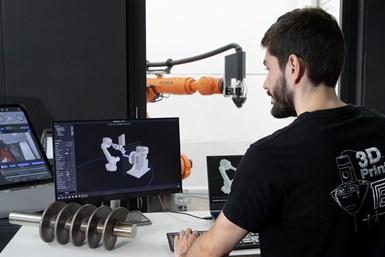Meltio Software Simplifies Wire-Laser Metal 3D Printing Technology
Meltio Space robot slicer employs a virtual model of the real robot movement.
Share
Read Next
Meltio created the Meltio Space toolpath generator to facilitate the use of its metal 3D printing solutions. By offering a user-friendly interface and comprehensive features, this robot slicer simplifies the integration of Meltio’s wire-laser metal 3D printing technology by offering a built-in robot library and postprocessors for some of the most popular robotic brands, including ABB, Kuka, FANUC and Yaskawa.
This toolpath generator software for the Meltio Engine Robot Integration offers an easy-to-use interface for planar, nonplanar, and variable extrusion toolpaths. It also includes 2-axis workpiece positioner interpolation, kinematics simulation, collisions check and cell configuration.
This slicer offers a new perspective on 3D printing by breaking free from the limitations of traditional 3-axis systems, and expands the possibilities by incorporating advanced robotic manipulation capabilities. Featuring an intuitive design, users can quickly adapt to and leverage the benefits of robotic additive manufacturing (AM) without requiring expertise in robotics or programming.
Also, Meltio Space goes beyond the constraints of traditional 3-axis systems. With its integration of a 6-axis robotic manipulator and 2-axis workpiece positioners, it opens up a new realm of possibilities for metal 3D printing. The comprehensive coordination, multi-axis toolpath generation, and enhanced design freedom provided by Meltio Space empowers users to create intricate, customized and highly detailed metal parts.
It is designed for using the Meltio Engine integrated into a robotic arm. Prior to launching Meltio Space, the company had agreements with 12 major software companies with which its technology is compatible and open. Now, the Meltio Space software facilitates the use or adoption of its wire-laser technology for industrial customers who do not have specific expertise in robotics and AM.
Meltio Space includes preset and recommended material profiles and 3D printing parameters. Moreover, Meltio Space removes complexity in the 3D printing workflow, making it accessible to industrial users of all levels. Whether it's understanding the interpolation of workpiece positioners or applying slicing strategies, Meltio Space streamlines the entire process, enabling users to embrace the power of AM with ease, offering a unified platform that enhances workflow efficiency and productivity.
With a strong focus on user experience, it offers a fully tailored customer journey centered around the seamless integration between the Meltio Engine and Meltio Space. The software offers custom-developed Meltio print profiles for the Meltio materials portfolio. With its intuitive design, users can quickly adapt to and leverage the benefits of robotic AM without requiring expertise in robotics or programming.
Meltio Space robot slicer employs a virtual model of the real robot movement. This advanced feature enables users to simulate the kinematics of the robot, ensuring accurate and precise printing. Additionally, the slicer performs collision checks with the part being printed, minimizing the risk of errors or damage during the additive manufacturing process.
- Learn more about Meltio’s wire-laser metal 3D printing technology for easier use, reliability. Its printing technology was developed to make the M450 metal 3D printer, Engine CNC Integration and Engine Robot Integration faster, more precise, easier to use and more reliable.
- Read about CNC Engineering’s collaboration with Meltio to design a solution that combines the power and reliability of FANUC CNC with cutting edge additive manufacturing technology.
Related Content
Two 12-Laser AM Machines at Collins Aerospace: Here Is How They Are Being Used
With this additive manufacturing capacity, one room of the Collins Iowa facility performs the work previously requiring a supply chain. Production yield will nearly double, and lead times will be more than 80% shorter.
Read MoreVideo: For 3D Printed Aircraft Structure, Machining Aids Fatigue Strength
Machining is a valuable complement to directed energy deposition, says Big Metal Additive. Topology-optimized aircraft parts illustrate the improvement in part performance from machining as the part is being built.
Read MoreWhy AM Leads to Internal Production for Collins Aerospace (Includes Video)
A new Charlotte-area center will provide additive manufacturing expertise and production capacity for Collins business units based across the country, allowing the company to guard proprietary design and process details that are often part of AM.
Read MoreThis Drone Bird with 3D Printed Parts Mimics a Peregrine Falcon: The Cool Parts Show #66
The Drone Bird Company has developed aircraft that mimic birds of prey to scare off problem birds. The drones feature 3D printed fuselages made by Parts on Demand from ALM materials.
Read MoreRead Next
Bike Manufacturer Uses Additive Manufacturing to Create Lighter, More Complex, Customized Parts
Titanium bike frame manufacturer Hanglun Technology mixes precision casting with 3D printing to create bikes that offer increased speed and reduced turbulence during long-distance rides, offering a smoother, faster and more efficient cycling experience.
Read MoreCrushable Lattices: The Lightweight Structures That Will Protect an Interplanetary Payload
NASA uses laser powder bed fusion plus chemical etching to create the lattice forms engineered to keep Mars rocks safe during a crash landing on Earth.
Read MoreProfilometry-Based Indentation Plastometry (PIP) as an Alternative to Standard Tensile Testing
UK-based Plastometrex offers a benchtop testing device utilizing PIP to quickly and easily analyze the yield strength, tensile strength and uniform elongation of samples and even printed parts. The solution is particularly useful for additive manufacturing.
Read More





















